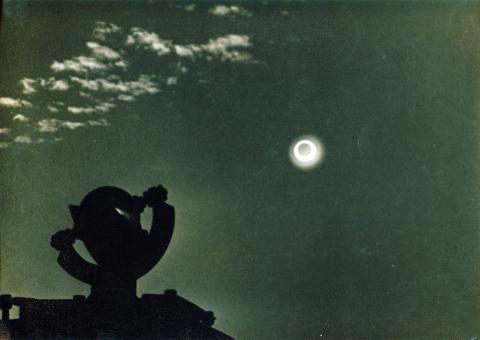Astronomy enthusiasts will be able to watch a live broadcast of an annular solar eclipse on the Web site of Central Weather Bureau, the meteorological office said yesterday.
The last time such a rare phenomenon was visible from Taiwan was on April 19, 1958.
The annular solar eclipse would not be visible again until June 21, 2020.

Photo courtesy of the Central Weather Bureau
The bureau said yesterday that the eclipse would begin in Taiwan between 6:08am and 6:10am on Monday next week and end at between 6:10am and 6:14am the same day.
The path of the annular solar eclipse will pass over residents in the northwestern part of Taiwan as well as the outlying islands of Kinmen and Matsu, who will be able to see the phenomenon clearly.
However, those living in the rest of the country will only be able to see part of the solar eclipse.
The bureau said the Dongjyu Island (東嶼) near Matsu would be the nation’s closest point to the center of the moon’s shadow. Residents of Dongjyu will be able to watch the annular eclipse for 4 minutes and 31 seconds, giving them the longest viewing window in the country.
The bureau’s observation station in Matsu also said that last time residents in Matsu saw an annular solar eclipse was on Dec. 15, 1610, when China was under the rule of the Ming Dynasty.
The station added that people in Matsu will not see the phenomenon again until Jan. 27, 2074.
Those living in Kinmen and the rest of Matsu will be able to watch the eclipse for about 4 minutes and 7 seconds and 4 minutes and 24 seconds respectively.
The bureau said the annular eclipse would last 1 minute and 37 seconds in Keelung, 1 minute and 41 seconds in Taipei, 1 minute and 38 seconds in New Taipei City (新北市), 2 minutes and 9 seconds in Taoyuan County and 1 minute 49 seconds in Hsinchu County.
Aside from the annular solar eclipse, a partial lunar eclipse will also take place on June 4, which could be seen nationwide.
The bureau said the partial lunar eclipse would begin at 6:35pm, with a missing corner first appearing on the southeast part of the moon.
The corner will gradually expand as the moon enters the earth’s shadow, and as a result about 37 percent of the moon’s surface will be covered by the Sun. The missing corner will disappear by 8:07pm and the moon will leave the earth’s shadow completely by 21:20pm.
Following the partial lunar eclipse, a transit of Venus will occur on June 6 and will be visible nationwide.
The astronomical phenomenon happens when the planet Venus passes directly between the sun and the earth.
The planetary phenomenon will occur at 6:11am, when Venus moves in from the northeast side of the sun. Observers will see a small black dot moving slowly across the sun, which will take 6 hours and 36 minutes.
The bureau said that the solar phenomenon will not occur again until Dec. 11, 2117 and advised those interested in watching the annular eclipse or Transit of Venus to watch them with special telescopes that can filter sunlight.

A relatively large earthquake may strike within the next two weeks, following a magnitude 5.2 temblor that shook Taitung County this morning, the Central Weather Administration (CWA) said. An earthquake struck at 8:18am today 10.2km west of Taitung County Hall in Taitung City at a relatively shallow depth of 6.5km, CWA data showed. The largest intensity of 4 was felt in Taitung and Pingtung counties, which received an alert notice, while areas north of Taichung did not feel any shaking, the CWA said. The earthquake was the result of the collision between the Philippine Plate and the Eurasian Plate, the agency said, adding

Snow fell in the mountainous areas of northern, central and eastern Taiwan in the early hours of yesterday, as cold air currents moved south. In the northern municipality of Taoyuan, snow started falling at about 6am in Fusing District (復興), district head Su Tso-hsi (蘇佐璽) said. By 10am, Lalashan National Forest Recreation Area, as well as Hualing (華陵), Sanguang (三光) and Gaoyi (高義) boroughs had seen snowfall, Su said. In central Taiwan, Shei-Pa National Park in Miaoli County and Hehuanshan National Forest Recreation Area in Nantou County saw snowfall of 5cm and 6cm respectively, by 10am, staff at the parks said. It began snowing

The 2025 Kaohsiung Wonderland–Winter Amusement Park event has teamed up with the Japanese manga series Chiikawa this year for its opening at Love River Bay yesterday, attracting more than 10,000 visitors, the city government said. Following the success of the “2024 Kaohsiung Wonderland” collaboration with a giant inflatable yellow duck installation designed by Dutch artist Florentijn Hofman, this year the Kaohsiung Tourism Bureau collaborated with Chiikawa by Japanese illustrator Nagano to present two giant inflatable characters. Two inflatable floats — the main character, Chiikwa, a white bear-like creature with round ears, and Hachiware, a white cat with a blue-tipped tail

HOLIDAY EXERCISE: National forest recreation areas from north to south offer travelers a wide choice of sights to connect with nature and enjoy its benefits Hiking is a good way to improve one’s health, the Forestry and Nature Conservation Agency said, as it released a list of national forest recreation areas that travelers can visit during the Lunar New Year holiday. Taking a green shower of phytoncides in the woods could boost one’s immunity system and metabolism, agency Director-General Lin Hwa-ching (林華慶) cited a Japanese study as saying. For people visiting northern Taiwan, Lin recommended the Dongyanshan National Forest Recreation Area in Taoyuan’s Fusing District (復興). Once an important plantation in the north, Dongyanshan (東眼山) has a number of historic monuments, he said. The area is broadly covered by